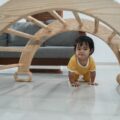Foam Climbing Blocks for Toddlers
Foam climbing blocks for toddlers offer a wide range of benefits that contribute to their physical, cognitive, and social development. These soft and lightweight blocks provide a safe environment for toddlers to explore and play, promoting gross motor skills, balance, coordination, and spatial awareness.
One of the key advantages of using foam climbing blocks is their versatility. Toddlers can stack them up to build towers or arrange them in different configurations, allowing them to engage in imaginative play while enhancing problem-solving skills. Additionally, these blocks can be used as stepping stones or obstacles during active play sessions, encouraging physical activity and stimulating healthy growth.
Another benefit of foam climbing blocks is their impact-absorbing nature. Unlike traditional wooden or plastic building blocks, foam blocks minimise the risk of injuries by cushioning falls and reducing the force exerted on little bodies. This safety feature gives parents peace of mind while allowing toddlers to freely explore and experiment with their surroundings.
Furthermore, foam climbing blocks foster social interaction among toddlers. They can collaborate with friends or siblings to build structures together or engage in pretend play scenarios that promote communication and cooperation skills. By sharing experiences with others through block play, toddlers develop important social-emotional competencies from an early age.
In conclusion, the benefits of using foam climbing blocks for toddlers are abundant. From promoting motor skill development to ensuring safety during playtime and fostering social interaction, these versatile and safe toys are a valuable addition to any toddler’s toy collection.

Enhancing Motor Skills
Foam climbing blocks for toddlers offer a range of benefits, and one significant advantage is their ability to enhance motor skills. As a parent or caregiver, it’s essential to provide opportunities for your little ones to develop their physical abilities, and foam climbing blocks are an excellent tool for achieving this.
- Balance and Coordination: Foam climbing blocks require toddlers to engage their core muscles and maintain balance while navigating through the structures. This helps them improve their coordination and body awareness, which are crucial skills for various daily activities.
- Strength Building: Climbing on foam blocks requires toddlers to use their upper body strength, such as their arms and shoulders, as well as lower body strength in their legs. Regular use of these blocks can help strengthen these muscle groups over time.
- Spatial Awareness: When playing with foam climbing blocks, toddlers learn how objects relate to one another in space. They have to analyse distances, heights, and angles while manoeuvring around the blocks. This enhances their spatial awareness and promotes problem-solving skills.
- Confidence Boost: Successfully navigating through foam climbing structures gives toddlers a sense of accomplishment and boosts their self-confidence. As they conquer new challenges like reaching higher levels or overcoming obstacles on the blocks, they gain confidence in their physical abilities.
- Cognitive Development: Foam climbing blocks also contribute to cognitive development by stimulating critical thinking skills. Toddlers must plan their movements ahead of time, strategize how to overcome barriers on the structure, and make decisions about where to place each step or handhold.
By incorporating foam climbing blocks into your toddler’s playtime routine, you provide them with an engaging way to enhance motor skills while having fun at the same time.
My name is Andrea Thompson and I’m a home based freelance writer. I’m 23 years old, married to my best friend, and mother to a wonderfully independent and opinionated 3 year old girl and step-mother to a sweet seven year old boy. I live in a tiny, little town in Kentucky, where I spend my free time fishing with my kids.
Writing has always been my passion, which I followed through high school, and for a while in college. Life happened, and once I discovered we were pregnant, I switched directions; opting for the healthcare industry because of the stability.
Finally, years later, I was in a place where I could leave the day job that never truly made me happy, and pursue my dreams. I’ve built, and am still building, my writing career from scratch. But, I’m passionate and I’m good at what I do. And, in the end, I can prove to my daughter that she can do anything she wants with this life.





